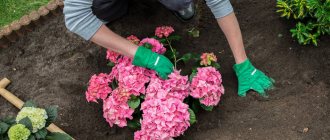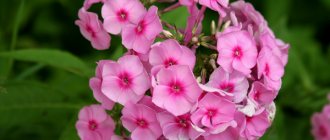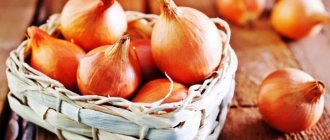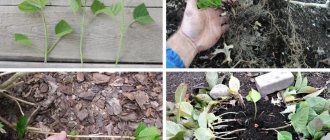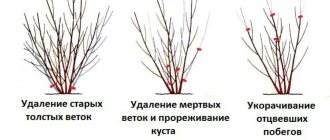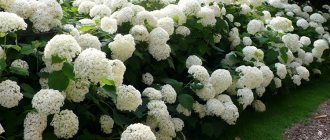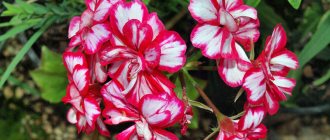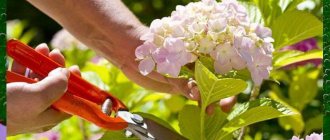Cuttings are the easiest way to propagate any type of hydrangea. Lignified cuttings take root poorly, so it is better to use annual green shoots. In this article we will tell you in detail how to grow spectacular hydrangea from cuttings.
Hydrangea can be propagated by cuttings in both spring and summer. But the most suitable time for this is mid-summer (shortly before flowering begins). Therefore, it is recommended to cut cuttings from the bush at the moment when the buds have just begun to form on the plant. But at the same time, it is important not to wait until the shoots become lignified, otherwise the cuttings will take root with difficulty.
It is best to cut shoots early in the morning. To prevent them from wilting, keep the hydrangea cuttings in water until cuttings.
How to properly propagate hydrangea by shoots and dividing the bush
One of the easiest ways to propagate hydrangea is by dividing the bush and young shoots.
Reproduction by shoots. Tree hydrangeas reproduce well by shoots. However, this method requires great attention and caution.
To do this, in the fall, remove the top layer of soil and, very carefully, so as not to damage the roots of the mother bush, separate the shoot.
The separated shoots are planted in a garden bed and left there for one or two years to grow, depending on the condition of the seedling. For the winter, the bed is covered with leaves and non-woven material.
Reproduction by dividing the bush. This propagation method is suitable for tree and broadleaf hydrangeas and is used mainly in early spring when transplanting. Before propagating hydrangea in this way, first water the bush abundantly, then dig it up and thoroughly wash the roots from the soil.
Then the bush is divided into several parts, the sections are sprinkled with coal for disinfection and the sections are immediately planted in a permanent place. When propagating hydrangeas by division, be sure to trim the ends of the shoots and slightly shorten the tips of the roots.
The video “Propagation of hydrangea in the garden” demonstrates the most popular methods:
Rules for growing hydrangea
This shrub prefers plenty of sun , so it is recommended to plant it in an open place.
But provided that there he will be protected from wind and drafts. Hydrangea does not require any special care. It is only important to choose the right soil composition for it - it prefers slightly acidic, loose compositions and does not tolerate lime impurities . Sand is also not suitable for it, since nutrients are washed out of it at high speed.
Further care consists of watering and fertilizing. For the winter, the bushes must be covered , since they are heat-loving and cannot tolerate significant drops in temperature.
To stimulate flowering, the shrub requires spring pruning. Trim the tops of the shoots, leaving three or four flower buds on each.
Reproduction of garden hydrangea by layering
The method of propagating hydrangea by layering is ideal for tree-like, broad-leaved and petiolate species. Other forms of these plants can be propagated in this way only if the bushes are small.
To do this, young outer flexible branches are bent from the growing bush and pinned to the ground (in a hole 15 cm deep) with brackets, tying the ends of the branches to pegs. To propagate hydrangea correctly, as experienced gardeners advise, at the very bottom of the hole, on the underside of the shoot, you first need to make an oblique cut several centimeters long. Then a match is inserted into the incision - tissue damage will accelerate the formation of roots in this place.
The bases of pinned shoots are sprinkled with a light mixture of soil and peat, and the soil is regularly moistened (to conserve moisture, cover the filled hole with film or mulch).
As shown in the photo, with such propagation of hydrangeas, the cuttings eventually form their own roots, and then they can be separated from the mother plant and planted the next year:
When to plant seedlings in a permanent place
Young hydrangeas are planted in the ground next year in the spring. Once the plants begin to show signs of growth, the seedlings begin to be watered regularly. When planting, place 1 tbsp in the hole. a spoonful of complex mineral fertilizer in granules.
Hydrangea is planted together with a lump of earth. To make it easier to remove the plant from the pot, do not water it for the last 2-3 days. After planting the seedling, it is recommended to shorten the shoots by 2/3 of their height - this measure will contribute to the development of a lush bush.
Method of propagating hydrangea by cuttings in spring (with video)
In general, pruning of hydrangeas that bloom on the shoots of the current year is carried out before the sap flows. However, if you want to take cuttings from the bushes, then do the pruning at the beginning of sap flow, before the buds open, for better rooting (rooting rate is about 70%). With this method of cuttings (woody cuttings), the planting material is of higher quality. So, to propagate hydrangeas in the spring, in the first half of April, when you see that the plant buds have begun to develop and have become slightly swollen, this means you can prune the bushes for cuttings. Tree hydrangea begins to develop after hibernation faster than paniculata, so pruning of tree hydrangea must be done earlier.
Trim the shoots, leaving 3-4 buds on them. To propagate hydrangeas in the spring, cut cuttings from the resulting branches so that each of them has 2 nodes. Make an oblique cut under the lower bud, and a straight one above the upper one, at a distance of 2-3 cm from it. After this, plant the resulting cuttings in a greenhouse in peat-sandy soil, deepening the lower bud by 3 cm, cover with plastic wrap or a plastic bottle and water generously. Then water the cuttings every day depending on the dryness of the soil.
For paniculate hydrangea, cut back last year's shoots by a third of their length. From the cut branches, cut cuttings according to a tree-like pattern and plant them in the greenhouse in the same way. Transplant rooted cuttings into open ground in the summer.
Watch the video of hydrangea propagation in spring to better imagine how this agricultural technique is performed:
Best time to breed
In order for the plant to take root faster, you need to choose the right time for planting. The month in which the work is carried out directly depends on the method of propagation of the flower:
- Divide the bush in spring, before the buds open.
- Jigging of shoots - autumn, after the leaves fall.
- Layering - spring or summer, when new large shoots appear.
- Planting seeds - February-March.
- Cuttings of green shoots - mid-summer.
- Cuttings of lignified shoots - end of September, October.
Propagation of hydrangea by woody cuttings in summer
Hydrangea cuttings are usually carried out in the summer, from mid-June to mid-July. An important point is to retain moisture in the cut stems, since this determines how productive the rooting will be.
Experienced gardeners recommend preparing planting material for propagating hydrangeas in the summer like this: cut off the branches in cloudy weather early in the morning and immediately divide them into cuttings. If planting is planned later, place them in water. Cut off the top of the branch with the bud. Divide the remaining stem into parts so that each of them has 2 to 3 pairs of leaves. Cut the top leaves by half and remove the bottom leaves. For two hours, place the shoots in a solution that stimulates root formation - root, zircon or heteroauxin. You can also prepare your own root former by dissolving a teaspoon of honey in water (200 g). The leaves should not touch the stimulant.
Or you can not use any stimulants at all - the roots are formed that way. When propagating hydrangea by cuttings, before planting in the ground, the upper cut is treated with brilliant green or garden varnish for disinfection. At a temperature of 15-25 degrees, hydrangea cuttings usually take root after a month. However, in summer cuttings the root system often does not have time to develop well, which can lead to their death in winter. Therefore, young plants need to be carefully covered before the first winter, protecting them from frost.
Also, when propagating hydrangea from lignified cuttings, they practice growing roots in water. Usually it takes 20-30 days. After the roots reach 3 centimeters in length, they are planted in the ground. However, this method is not very successful - often the lower tips of the cuttings rot and the plant dies.
Diseases and pests
Diseases
Hydrangea is susceptible to many diseases. They can occur if the conditions for healthy plant growth have been disrupted.
- Tracheomycosis wilt
- Gray rot
- Powdery mildew
This disease is caused by soil fungal pathogens. The first sign of plant damage is that the roots rot and turn brown. The flow of nutrients decreases, and the upper shoots begin to wither. In this case, it is almost impossible to save the flower, so the best way out is to take preventive measures.
Fungal disease of the plant. It primarily affects young shoots with a light gray rash. As the disease develops, it completely affects the hydrangea. High humidity has a beneficial effect on the development of the disease. To cure this disease, you need to remove the infected parts of the plant, and then disinfect the container in which the hydrangea grows. For prevention, treat the plant with Fundazol.
Fungal disease. Pathogens often live directly in the soil. A white coating appears on the affected areas. Later, the leaves begin to fade and the tops of the shoots dry out. If the plant is severely damaged, flowering does not occur. To cure a plant, you need to remove its infected parts, then maintain favorable temperature and light conditions, as well as properly fertilize it. In case of severe damage, Vitaros or Fundazol should be used.
Pests
Pest activity can greatly harm hydrangeas if the necessary measures are not taken in time.
Fitoverm is effective against aphids, spider mites and other parasites . If there are not very many insects, they can be removed mechanically.
A special type of pest is snails . Found in gardens and open areas. They penetrate the soil and, with the onset of spring, eat the roots of the plant. Usually, clutches of eggs are left there. To prevent the appearance of snails, you need to periodically check the ground around the bushes for their presence and remove them. In cases where there are too many snails, you can use chemicals that are sold in specialized stores.
Thus, tree hydrangea is a very beautiful plant, but caring for it is not easy. The main thing is to choose the right place for it, follow the watering regime and treat diseases in a timely manner, and then the plant will grow beautiful and healthy.
Method of propagating hydrangea by cuttings in autumn
You can also take cuttings from large-leaved hydrangea bushes in the fall in September-October, before the winter shelter of the bushes. To propagate hydrangeas in the fall, cut the shoots and cut the cuttings so that each has 2 leaf nodes, remove the lower leaves, cut the upper ones in half, leaving 1 cm of shoot from the lower bud and the upper leaf. Dip the cutting with the lower cut into a rooting accelerator, then deepen it into garden soil in pots up to the top leaves.
When propagating hydrangeas in the fall, compact the soil around the cutting well and coat the top cut with brilliant green for disinfection. Several cuttings can be planted in pots for rooting, depending on the volume. After planting the cuttings in the ground to a depth of 1 cm, add the Glyokladina tablet - it will protect the plant from root rot. Place the pot in a clear plastic bag, tie it and place it on the windowsill. In winter, when the weather is frosty, protect the pots from the cold with newspapers and make sure that there is no ice formation inside the bags.
When propagating garden hydrangea, cuttings need to be ventilated several times a week, but for a short time, so that the young leaves do not have time to dry out. Be sure to remove old fallen leaves. In spring, in cloudy weather, take the pots outside (balcony) to harden the plants. Determine readiness for planting in open ground when the leaves curl and droop.
The video “Propagation of hydrangea by cuttings” shows how this event is carried out correctly:
Seed method
Seed propagation of hydrangea is one of the longest processes. But it is thanks to him that new varieties of crops are born. Flower seeds do not require preliminary preparation. They are sown in boxes immediately after collection. You can buy the soil at a garden center or prepare it yourself from equal parts of garden soil, humus, peat and sand. Before carrying out work, the soil must be well moistened.
Seeds are sown superficially, without embedding in the ground. The crops are covered with plastic film to create greenhouse conditions and placed on a windowsill with diffused light. The first shoots appear after 20-25 days. They are opened and carefully watered. After the formation of 3-5 leaves, it is recommended to pick. The seedlings are kept in the room for 2 years, cared for like a houseplant. And only in the third year, young seedlings 40-50 cm high are moved to the site.
Folk method of propagating hydrangeas
In the spring, they acquire strong young hydrangeas, which it is advisable to propagate. A healthy hydrangea with a closed root system (in a pot) develops well over the season; By autumn, the plant has formed good roots and strong shoots. At the end of August or at the beginning of September, the entire hydrangea bush removed from the pot is buried (horizontally) with loose fertile soil. First, carefully remove all weak and immature shoots, inflorescences and leaves from the bush.
When sprinkled with earth, the hydrangea rhizome itself should be buried below the shoots of the bush. That is, you need to lay the hydrangea bush with its roots down in the dug trench, placing it at a slight slope (about 35 degrees).
When the hydrangea bush is correctly placed, cover the rhizome of the plant with soil and compact it for reliable contact with the roots; water. Add a little more soil to the rhizome and compact it again.
When the hydrangea roots are securely closed, all that remains is to place each hydrangea branch separately (in a fan) in the trench, and then cover the entire bush with soil on top. In the spring, when the soil warms up, young shoots will emerge from this completely buried hydrangea bush. As many individual stems will sprout - future bushes with independent roots - as there were buds on the mother bush. All that remains is to divide the hydrangea bush into sections and plant them. As a rule, all young hydrangea bushes formed using this method bloom in the same year.
This technique can reliably protect flower buds in the ground from frost, and multiply the bush of your favorite plant exponentially.
Watch the video on how to propagate hydrangea in the garden in different ways:
Description of the tree hydrangea variety
This is a large-flowered picturesque shrub with a shoot height of 1-2 m and a superficial root system. Tree hydrangea is best planted in semi-shaded places. The trunks become woody after a year. The bark is flaky. Young shoots are slightly fluffy and green. The plant has large, delicate, bright green leaves up to 18-20 cm long and 10-12 cm wide. They retain their color in the fall, only in some varieties they turn slightly red.
Hydrangea
Corymbose inflorescences up to 15 cm in diameter are composed of white-cream or slightly greenish flowers with a diameter of 2 cm. There are pink-reddish tree-like varieties. Hydrangeas bloom from July to the end of September. The inflorescences contain flowers from which seeds develop. They are in the center. Sterile, large flowers located at the edges.
Tree hydrangea tolerates frosts down to 30 °C. Even if the shoots freeze, the bush recovers from the root. The plant is moisture-loving; in sunny areas it requires regular watering with mandatory mulching of the tree trunk. It prefers soils with a pH of 5, but this particular species tolerates alkaline substrates more easily than other hydrangeas. Hydrangea can be propagated in spring without any hassle by dividing roots and layering. Propagation of the crop by cuttings is recognized.
Breeders also developed various ornamental varieties based on the natural species that grows in eastern North America:
- snow-white Annabelle;
- greenish-cream Grandiflora;
- pink Invincibelle (Pink Annabelle);
- white, with strong trunks Incredibol (Strong Annabelle).
Important! Cuttings of tree and paniculate hydrangeas take root easily.
